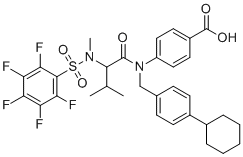
PG-S3-001
CAS No. 2047372-50-7
PG-S3-001( —— )
Catalog No. M13182 CAS No. 2047372-50-7
PG-S3-001 is a small molecule STAT3 inhibitor that binds to STAT3 protein potently with Kd of 324 nM by surface plasmon resonance.
Purity : >98% (HPLC)
 COA
COA
 Datasheet
Datasheet
 HNMR
HNMR
 HPLC
HPLC
 MSDS
MSDS
 Handing Instructions
Handing Instructions
| Size | Price / USD | Stock | Quantity |
| 100MG | Get Quote | Get Quote |


|
| 200MG | Get Quote | Get Quote |


|
| 500MG | Get Quote | Get Quote |


|
| 1G | Get Quote | Get Quote |


|
Biological Information
-
Product NamePG-S3-001
-
NoteResearch use only, not for human use.
-
Brief DescriptionPG-S3-001 is a small molecule STAT3 inhibitor that binds to STAT3 protein potently with Kd of 324 nM by surface plasmon resonance.
-
DescriptionPG-S3-001 is a small molecule STAT3 inhibitor that binds to STAT3 protein potently with Kd of 324 nM by surface plasmon resonance; shows no effect in a kinome screen (>100 cancer-relevant kinases); inhibits phosphorylation of STAT3 at Y705, inhibits patient-derived pancreatic cancer cell proliferation in vitro and in vivo in the low micromolar range; exhibits in vivo efficacy on pancreatic cancer xenografts.
-
In Vitro——
-
In Vivo——
-
Synonyms——
-
PathwayJAK/STAT Signaling
-
TargetSTAT
-
RecptorSTAT
-
Research Area——
-
Indication——
Chemical Information
-
CAS Number2047372-50-7
-
Formula Weight652.677
-
Molecular FormulaC32H33F5N2O5S
-
Purity>98% (HPLC)
-
Solubility——
-
SMILES——
-
Chemical Name4-{(4-Cyclohexyl-benzyl)-[3-methyl-2-(methyl-pentafluorobenzenesulfonyl-amino)-butyryl]-amino}-benzoic acid
Shipping & Storage Information
-
Storage(-20℃)
-
ShippingWith Ice Pack
-
Stability≥ 2 years
Reference
1. Arpin CC, et al. Mol Cancer Ther. 2016 May;15(5):794-805.
molnova catalog



related products
-
Totrombopag
Totrombopag (SB559448) is a candidate compound for action on RSV polymerase.
-
Pimozide
Pimozide is an antipsychotic agent that acts as an antagonist of the D2, D3, and D4 receptors and the 5-HT7 receptor.
-
GTS 21 dihydrochlori...
GTS 21 dihydrochloride is a nAChRs agonist. nAChRs are neuron receptor proteins that activated by the binding of the neurotransmitter ACh.



 Cart
Cart
 sales@molnova.com
sales@molnova.com


